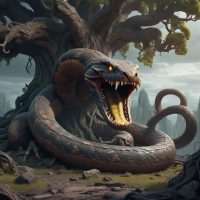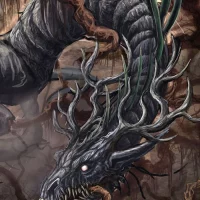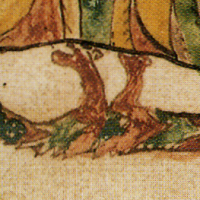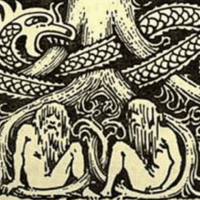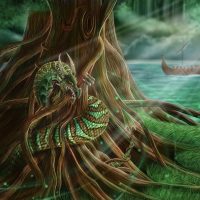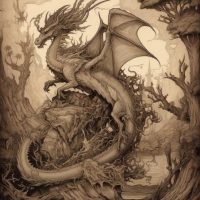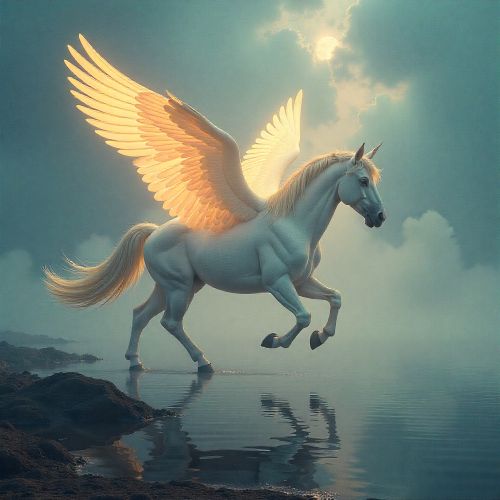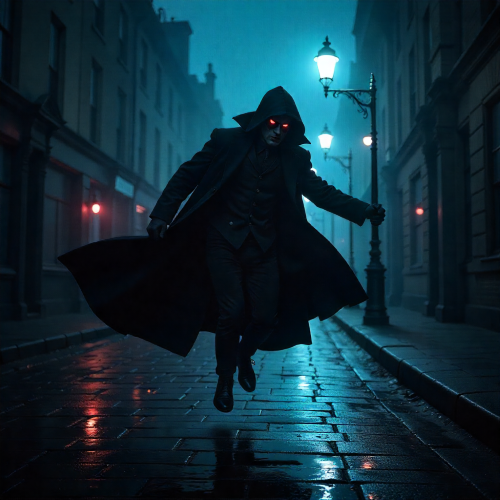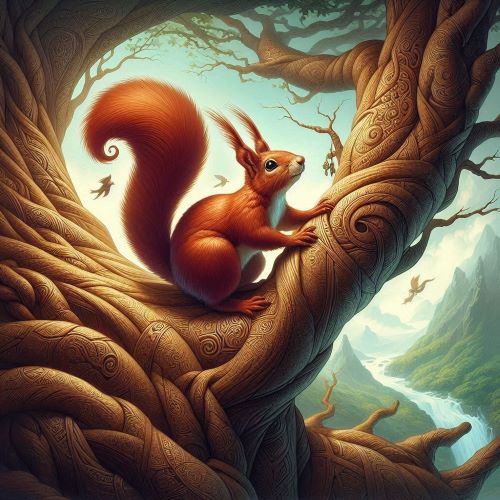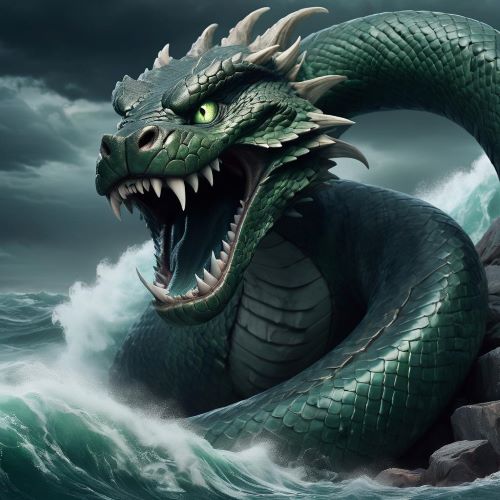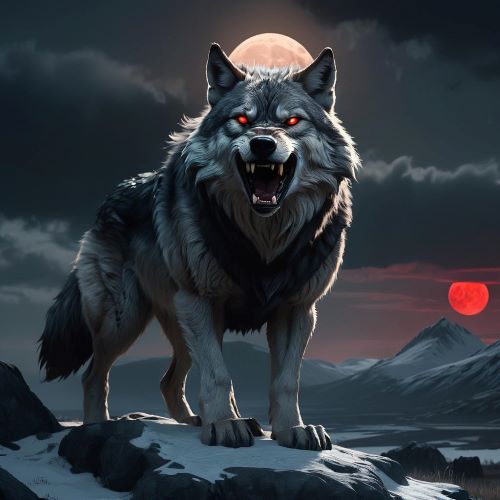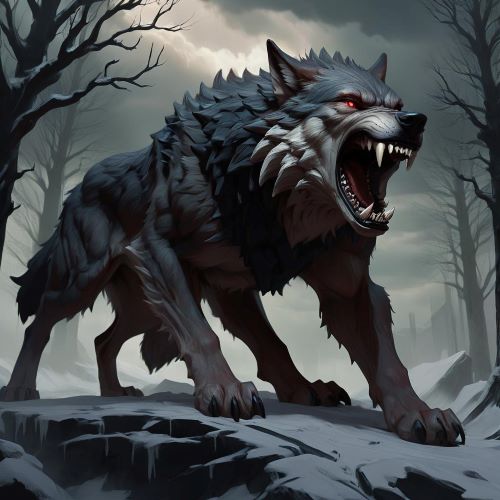Nidhogg : The Primal Serpent
Listen
At a glance
| Description | |
|---|---|
| Origin | Norse Mythology |
| Classification | Animals |
| Family Members | N/A |
| Region | Iceland, Denmark, Finland |
| Associated With | Chaos Destruction |
Nidhogg
Introduction
Nidhogg, also known as Níðhöggr in Old Norse, is a significant presence in Norse mythology, often depicted as a dragon or serpent dwelling at the roots of Yggdrasil, the cosmic world tree. Its name, which translates to “Curse-striker” or “He Who Strikes with Malice,” carries ominous connotations, reflecting its menacing nature. Among the diverse beings of Norse lore, Nidhogg stands out as a primal force, embodying both destructive and regenerative forces. As the colossal serpent that gnaws at the roots of Yggdrasil, Nidhogg occupies a unique position in Norse cosmology, symbolizing the perpetual cycle of creation and destruction. With its name evoking chilling imagery of a monstrous serpent unraveling the very fabric of existence, Nidhogg epitomizes chaos and destruction, ceaselessly working to disrupt the delicate balance of the cosmos.
Physical Traits
Nidhogg is typically depicted as a formidable dragon or serpent, inspiring fear with its imposing presence. Its primary role involves incessantly gnawing at the roots of Yggdrasil, symbolizing a perpetual threat to the world tree and the entire cosmos. Descriptions of Nidhogg’s physical form vary, but they consistently portray an immense creature with coils encircling Yggdrasil’s roots. Its scales are likened to the darkness of the abyss, signifying its connection to the underworld, while its eyes possess a sinister gleam of intelligence. The creature’s razor-sharp teeth evoke the relentless decay it inflicts upon the World Tree, perpetuating chaos and destruction. Stories depict Nidhogg as a monstrous entity, sometimes endowed with feathered wings or fearsome claws, yet always driven by an insatiable hunger for the lifeblood of existence. Its dwelling in Hvergelmir, a venomous spring beneath Yggdrasil’s roots, underscores the monstrous nature of Nidhogg, positioned ominously close to the wellspring of life in Norse mythology, poised to wreak havoc upon the cosmos.
Family
Information regarding Nidhogg’s family lineage remains elusive within Norse mythology. The Prose Edda, a compilation of 13th-century Icelandic texts, hints at the existence of other serpents dwelling alongside Nidhogg in Hvergelmir, suggesting they could be either offspring or companions in its destructive endeavors.
Speculation arises concerning a potential connection between Nidhogg and Jormungandr, the Midgard Serpent, another colossal serpent encircling the world in Norse lore. Both beings share serpentine traits and a link to the foundation of the world. Despite this, concrete evidence validating such a connection is absent.
In Norse mythology, Nidhogg’s familial background remains ambiguous. It coexists with various serpents and dragons within the realm of Yggdrasil. Notably, Nidhogg shares a narrative connection with Ratatoskr, a squirrel serving as a messenger between the eagle atop Yggdrasil and the serpent below. While lacking direct familial ties, this dynamic underscores the intricate relationships binding the inhabitants of the Norse cosmos, with Nidhogg embodying chaotic forces counter to the cosmic order maintained by the gods.
Other names
In Old Norse, the name Nidhogg is alternatively spelled as Níðhǫggr. It is commonly anglicized as Nidhogg and is also known as “the Malice Striker” or “the Curse-striker.” Like many figures in Norse mythology, Nidhogg is recognized by various names and epithets across different sources and traditions. Apart from its primary moniker, which signifies “Malice Striker” or “Dread Biter,” Nidhogg is also denoted as “The Corpse Tearer” and “He Who Strikes with Malice.”
The name Nidhogg carries significant meaning. In Old Norse, “níð” translates to “malice” or “curse,” while “höggr” means “striker” or “he who tears.” Thus, Nidhogg can be interpreted as the “Malice Striker” or “Curse-Biter,” befitting its role as a relentless force seeking to dismantle the world. Notably, some sources identify Nidhogg as the “Nastronder Dragon,” linking it to Nástrandir, a grim realm in Helheim (the underworld) where oathbreakers, murderers, and adulterers face punishment. This association hints at a potential dual role for Nidhogg, as both the destroyer of the world tree and a tormentor of the damned.
Powers and Abilities
Nidhogg’s role as the creature assigned to gnaw at the roots of Yggdrasil underscores its immense strength and resilience. Its relentless chewing serves as a potent symbol of the perpetual cycle of destruction and renewal inherent in Norse cosmology. By corroding the foundations of Yggdrasil, Nidhogg embodies the inevitability of decay, even for the mighty World Tree itself. Its presence beneath Yggdrasil’s roots serves as a constant reminder of the fragility of existence and the ever-looming threat of chaos beneath the ordered surface of the cosmos.
Gnawing at the roots of Yggdrasil constitutes Nidhogg’s primary activity, posing a significant threat to the stability of the cosmic tree that binds the Nine Worlds. This destructive action stands in stark opposition to the gods and the established cosmic order, symbolizing chaos and upheaval. Nidhogg’s relentless efforts aim to regress the cosmos into chaos, challenging the prevailing order.
Central to Nidhogg’s power is its colossal size and strength, enabling it to gnaw tirelessly at Yggdrasil’s roots, a task demanding unparalleled fortitude. This perpetual gnawing not only weakens the World Tree but also embodies the constant encroachment of chaos upon order. Moreover, Nidhogg’s association with Hvergelmir, the venomous spring, suggests a connection to poisonous toxins that further undermine Yggdrasil’s integrity and contribute to the overarching decay it represents.
Modern Day Influence
Nidhogg’s influence permeates modern pop culture, particularly within the realm of video games. Notably, it features in popular titles like “World of Warcraft” and even has an indie game named after it. These representations typically portray Nidhogg as a formidable dragon, echoing its depiction in Norse mythology. Moreover, Nidhogg’s appearance in video games, such as the aptly titled “Nidhogg” series, underscores its enduring appeal and its ability to resonate with modern audiences, further cementing its place in contemporary pop culture.
In contemporary times, Nidhogg continues to captivate audiences across various media forms, including video games, fantasy novels, and role-playing games. Often depicted as a monstrous adversary, Nidhogg poses a significant challenge for heroes to overcome. Its portrayal as a colossal serpent embodying chaos and destruction remains a compelling symbol in narratives exploring themes of existential dread, the cycle of life and death, and the eternal struggle between order and chaos.
Related Images
Frequently Asked Questions
What is lorem Ipsum?
I am text block. Click edit button to change this text. Lorem ipsum dolor sit amet, consectetur adipiscing elit. Ut elit tellus, luctus nec ullamcorper mattis, pulvinar dapibus leo.
What is lorem Ipsum?
I am text block. Click edit button to change this text. Lorem ipsum dolor sit amet, consectetur adipiscing elit. Ut elit tellus, luctus nec ullamcorper mattis, pulvinar dapibus leo.
What is lorem Ipsum?
I am text block. Click edit button to change this text. Lorem ipsum dolor sit amet, consectetur adipiscing elit. Ut elit tellus, luctus nec ullamcorper mattis, pulvinar dapibus leo.
What is lorem Ipsum?
I am text block. Click edit button to change this text. Lorem ipsum dolor sit amet, consectetur adipiscing elit. Ut elit tellus, luctus nec ullamcorper mattis, pulvinar dapibus leo.
What is lorem Ipsum?
I am text block. Click edit button to change this text. Lorem ipsum dolor sit amet, consectetur adipiscing elit. Ut elit tellus, luctus nec ullamcorper mattis, pulvinar dapibus leo.


